Quest For Motors' Hidden Abilities and New Potentials
Lecture 10: Chuo Shinkansen (Bullet Train)—The World's Largest Motor
In Volume 1, I wrote that "new motors are often invented when a country's industry and level of science are developing." Currently in Japan, the world's largest motor is being developed. This is the maglev Chuo Shinkansen that will connect Tokyo and Osaka. This is our topic in this final volume.
◇ Chuo Shinkansen-- world's largest and fastest motor
As shown in Fig. 1, the Chuo Shinkansen runs by a mechanism in which the entire car is lifted above the rails based on the principle of magnetic levitation and propelled by onboard superconducting magnets activated when current flows in the coils embedded in the side walls. This is basically a very simple construction, involving no gears.
The greatest difference with conventional trains is that there are no wheels to support the train and provide traction. Instead, electromagnetic force is used to push against the track and propel the train. It is a transportation system that makes direct use of electromagnetic force. In the previous volume, I wrote about compact motors for drones (multicopters), where the principles of fluid mechanics were utilized through the use of propellers to transport light-weight objects over a relatively short distance. Chuo Shinkansen will use the world's largest and fastest motor for long-distance mass transportation.
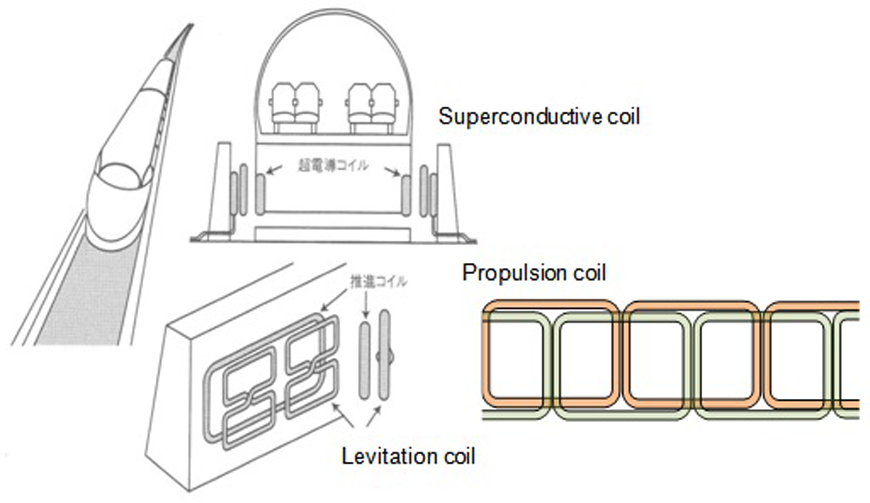
Fig. 1 Mechanism of Chuo Shinkansen
◇ Recalling Einstein's theory of relativity
In Volume 3, I wrote that Einstein "caught a large fish" with his paper, "On the Electrodynamics of Moving Bodies." Since we are discussing the linear motor, I wish to use this occasion to make some additional comments regarding Einstein's electrodynamics so that the readers may appreciate some of the essence of his theory. While Einstein's paper contained no illustrations, diagrams of relative motion are often presented in physics textbooks and introductory books to explain the theory of relativity. I shall draw such a diagram using the Chuo Shinkansen as the model, which is shown in Fig. 2. Einstein's theory of relativity states that the relation between position x and time t in one inertial frame K can be transformed to that in another inertial frame K', which is moving at constant velocity v with respect to frame K, by the Lorentz transformation.

Here c is the speed of light (300,000km/s).
Although most introductory books refer to the faster or slower rates at which clocks mark time to explain the above expression, this by itself cannot be said to be electrodynamics. Einstein's other assertion consisted of the law of magnetic and electric fields, which is given below.

The magnetic flux density B corresponds to time t, and
The electric field strength E corresponds to position x.
The electromagnetic field and space-time are thus inextricably related.

◇ Going back to the origins of electrodynamics
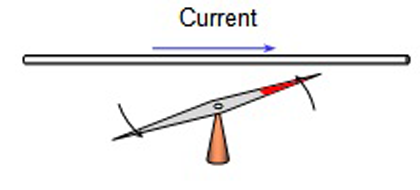
This is none other than the principle of the motor, but carrying the concept a bit further, we can see that it implicitly includes the static relation between the magnetic field strength H and electric current I. It was the Frenchman, Andre-Marie Ampere, who expressed this relation in mathematical terms. Static means that the phenomenon is unrelated to time derivatives. What then happens when the electric wire or magnetic needle moves, which can be said to be a primitive motor? It was Michael Faraday (1791-1867) who demonstrated this phenomenon in London in 1831. The phenomenon, known as the law of electromagnetic induction, is illustrated in Fig. 4. In this figure, the electromagnet remains still in space, and the time-varying magnetic field gives rise to a voltage.
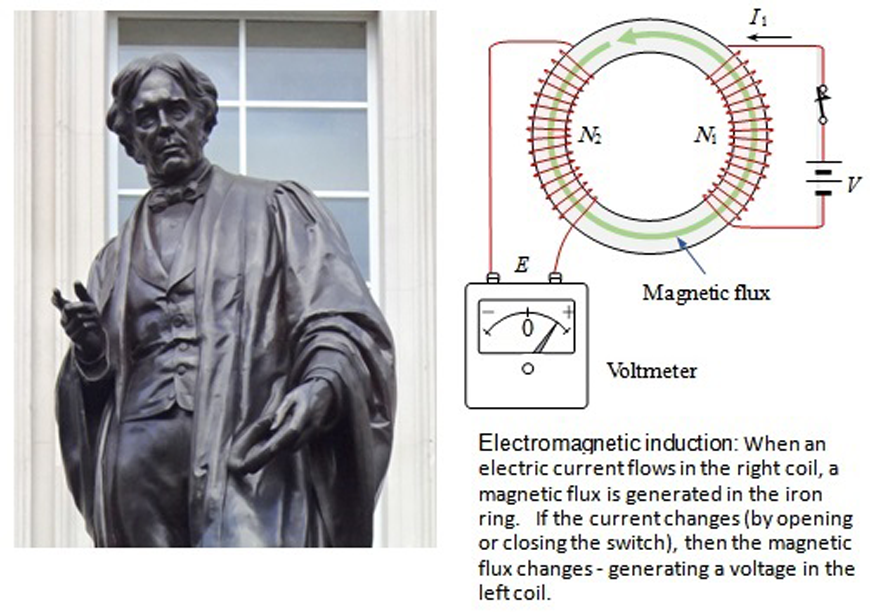
Institution of Engineering and Technology in London. In his left hand
is the iron ring wound with a coil which he used in his public lecture
on electromagnetic induction. (The Institution of Engineering and Technology Archives)
If we examine this phenomenon further, we arrive at an explanation of why voltage is generated (electricity is induced) when a wire passes through a magnetic field, that is, the principle of electrical generation. We can see that the velocity v with which the wire goes through the magnetic field is important. The year Faraday discovered electromagnetic induction, James Clerk Maxwell (1831 -1879) was born in Scotland.
Now the question arises: do the experiments of Ørsted's and Faraday represent independent phenomena? In fact, they are two sides of the same coin, which is explained in terms of Fleming's left- and right-hand laws shown in Fig. 5. This suggests that the motor can act as a generator, and vice versa. Was the relation between the generator and motor discovered based on logical thinking of this sort? The answer is no, and it was accidentally discovered at the World Exposition held in Vienna in 1873, when one of the two generators on display began moving due to an erroneous connection made by the engineer.
It was Maxwell who examined Ampere's theory and Faraday's discovery in mathematical terms, suggested the existence of electromagnetic waves, and proposed that light is a type of electromagnetic wave. About this Wikipedia says: Around 1862, while lecturing at King's College, Maxwell calculated that the speed of propagation of an electromagnetic field is approximately that of the speed of light. He considered this to be more than just a coincidence, commenting, "We can scarcely avoid the conclusion that light consists in the transverse undulations of the same medium which is the cause of electric and magnetic phenomena."
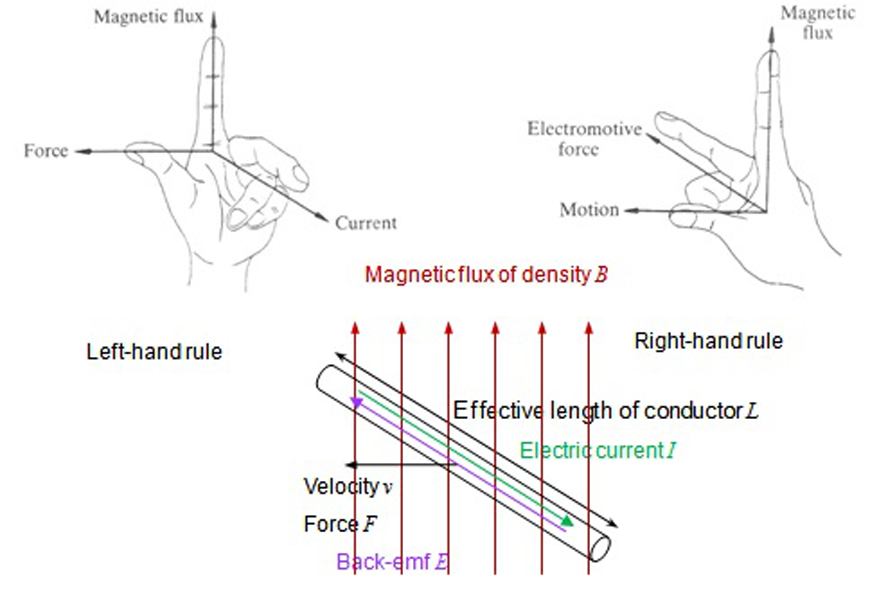
gives the relation of force and electric current, which is expressed F=BLI,
while the right-hand rule gives the relation of induced voltage and speed, expressed
by E=BLv. The proportionality constant is BL in both cases. Thus, the motor and
generator represent the same physical phenomenon.
(B is the flux density, L is the conductor length)
Einstein was born in March, 1879, in Germany, and Maxwell died in November of the same year. In 1887, a team of experimental physicists in the United States verified that the speed of light is the same regardless of the observer's velocity. Based on a careful examination of Maxwell's equations, Einstein published in his paper on electrodynamics the Principle of Invariant Light Speed as a major premise, much like the parallel postulate of Euclidean geometry. In this writer's view, the relationship between the motor and generator is clearly described by Poynting's theorem, described in Vol. 4, and Einstein's theory of relativity. In this sense, we can say that the theoretical framework of modern electrodynamics was established by Einstein.
Although the Chuo Shinkansen, when completed, will become the world's fastest railway, its speed is still less than 1 millionth that of light, and the reader may question the necessity of alluding to the theory of relativity. Perhaps so, but one point I wish to add is that Einstein theory suggests that the motor is an embodiment of the multidimensional aspects of space-time. The Chuo Shinkansen is an attempt to realize this mechanism on a large scale using the world's foremost technologies.

expressed by spheres in quantum mechanics, various other methods of
representing electrons have been attempted.
◇ Superconductivity
In the linear motor of the Chuo Shinkansen, the main component of magnetic field B is generated by the superconductive magnet, while the electric field E is created by the coils arranged along the side walls.Superconductivity is a mysterious phenomenon. Normally, the voltage is described as the action that generates the electrical current, where Ohm's law describes the relationship between voltage V and current I in a conducting wire. This relationship is expressed by the simple relation V=RI, where is called the electrical resistance. Electrical resistance is thought to be caused by the thermal motion of atoms that make up the metal (a phenomenon in which the atoms move about in random manner due to collisions). The classical theory was that this type of motion disappears when the temperature is reduced to absolute zero, so that R=0. In reality, this is not what happens, and in 1911 it was discovered that the electrical resistance disappears abruptly below a certain temperature. This is what is known as superconductivity, and one of those who explained this phenomenon was John Bardeen, whose short biography is presented below.
In simple terms, this can be explained as follows. Note that, when fish form a school, they do not run into one another. For electrical current to flow freely, the electrons in metal must be able to freely move en masse without colliding with atomic nuclei, but this requires a specific interaction between electrons. The BCS theory provides an explanation for this. In technical terms, this is sometimes explained as follows: "a large group of individual electrons moving freely obey Fermi statistics, while two electrons that form a Cooper pair by interacting with a crystal lattice under very low temperatures obey Bose-Einstein statistics (See Fig.6). This explains why the electrons flow in an orderly manner." The names Fermi (an Italian physicist) and Bose (an Indian physicist) come up when describing the relationship between the conditions or movement of electrons and electrical current in quantum statistical mechanics, which progressed from the wave mechanics of Schrödinger and Brillouin, who were mentioned in Vol. 8. I wrote about semiconductors in Vols. 7 and 8; the electronic phenomena in semiconductors obey Fermi statistics. Incidentally, Einstein's name appears along with Bose in the physics of superconductivity, but this theory does not take into account the theory of relativity.
In the experimental track of the Chuo Shinkansen, niobium-titanium alloy is used as the superconductive material, which is cooled to -269℃ by liquid helium to create the superconductive state. In other words, a giant magnet is created in place of a permanent magnet to generate the magnetic field to propel and lift the train. However, the coils on the side walls use regular copper at ambient temperature, and so a large copper loss is generated. Reduction of the energy cost is likely to be an issue that must be addressed.
◎Some final comments
On the front page of the November 6, 2016, issue of the Yomiuri Shimbun newspaper, as part of a continuing series called "Reading the Earth," there is an article written by Yoshiyuki Kasai, the honorary president of JR Tokai, where he discusses the economic significance of the Chuo Shinkansen. When finished, it will be capable of transporting (a maximum of) 100,000 passengers one way from Tokyo to Osaka or from Osaka to Tokyo.
It was in 1964 that the current Shinkansen line opened between Tokyo and Osaka, and the Tokyo Olympics was held in October that year. The next Tokyo Olympic is planned in 2020, seven years after which the linear Chuo Shinkansen will begin transporting people between Tokyo and Nagoya in 40 minutes. This will be a realization of "All for dreams," the Nidec corporate slogan.
If we consider that we are currently in the first stage of motor science in Japan, the second stage may be taking place around then. At the forefront of physics, where investigations on the origins of the universe or the fundamental constituents of matter are being undertaken, the universe is considered to consist of ten or more dimensions. The physics of Einstein's electrodynamics also considers ten dimensions, consisting of the three-dimensional vectors to represent the electric and magnetic fields, E and B, the three dimensions of space, and time. The principles of the motor which we recognize and utilize today are perhaps only a small part of the possibilities hidden within the multidimensional universe.
By the time the Chuo Shinkansen is running, materials research on the basic elements that make up the motor may have progressed to such an extent that it may be possible to achieve superconductivity at normal room temperatures. But this will require the appearance of highly talented young researchers with a thorough grasp of the basic sciences. I shall look forward to a future in which the truth expressed by E=mc2, which is the culmination of the theory of relativity as I wrote in Vol. 3, can be realized in a motor by means of a safe technology and without contributing to global warming. If achieved, such technology will be in accord with the COP21 "Paris Agreement," which set forth specific measures on global climate change to be implemented from 2020 onwards with the goal of reaching net zero emission of greenhouse gases.
Quest for Motors' Hidden Abilities and New Potentials: The End
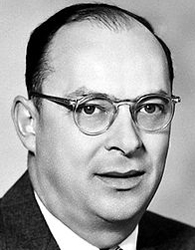
(1908-1991)
John Bardeen was born in 1908 in Wisconsin to a professor of anatomy as his father and an educator as his mother. As I wrote in Vol. 2, Bardeen and Teare were classmates at the University of Wisconsin. While Teare, a physics major, was honing his talent for applied mathematics as a student, Bardeen, who was majoring in electrical engineering, was developing a talent to delve deeply into physical problems. After working for four years at the Naval Ordinance Laboratory during World War II, he joined Bell Labs in 1945 where he was a member of a Solid Physics Group.
Tadashi Sasaki, who during World War II had been studying vacuum tubes for the purpose of jamming the radars on American bombers, was sent after the war by the Supreme Commander for the Allied Powers (SCAP, commonly referred to as GHQ - General Headquarters - in Japan) to the United States, where he became acquainted with Bardeen. This is when he heard about amplifiers that employed solids, which is the transistor. Since this meeting, Bardeen began his associations with Japanese scientists and engineers.
As I wrote in the short biography of Shockley in Vol. 7, Shockley, Bardeen, and Brattain invented the transistor in 1948. After the invention, Bardeen found it increasingly difficult to work under Shockley at Bell Labs, which he left to join the University of Illinois, where he took up research in superconductivity in earnest. At the banquet after he received the Nobel Prize in physics in 1956 for the invention of the transistor, he told King Gustav VI of Sweden that he had left behind two of his three children because of their studies but promised that he would bring all of them the next time.
In 1953, Bardeen participated in the International Conference of Theoretical Physics held in Tokyo and Kyoto, where he took special notice of the phonon theory of Sadao Nakajima, who later became professor at Tokyo University. Subsequently, he developed the BCS theory, which takes the initials of Bardeen and his collaborators Leon Cooper and John Schrieffer, his doctoral student. Yet, this theory cannot explain all aspects of superconductivity. When he was invited to receive his second Nobel Prize in physics in 1972, he brought along his entire family including his grandsons.

